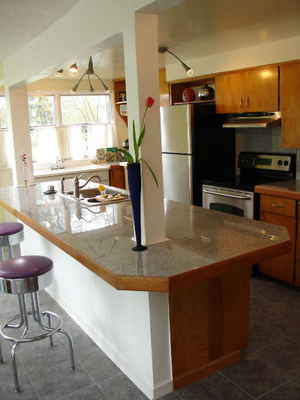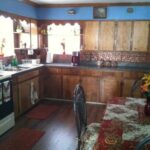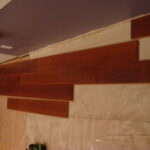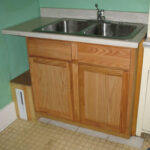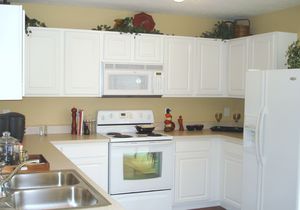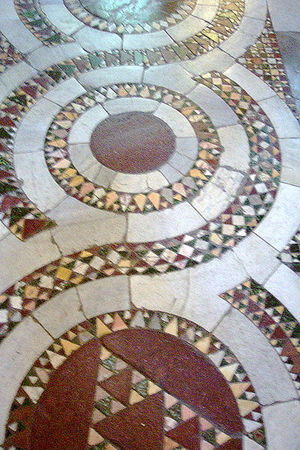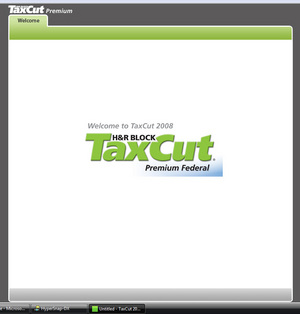One of the most frequently asked questions among those shopping for new cabinets and countertops is, “What type of countertops should I purchase?” Most people don’t realize how many different countertop materials are available until they begin planning their new kitchen or bathroom. THERE ARE SEVERAL countertop materials to choose from, so in an effort to help you find the right fit for your home, below you will find a comprehensive overview of some of the most popular countertop materials, including the advantages of disadvantages to each.
Laminate
Laminate is one of the least expensive countertop materials available. It is offered in a wide variety of colors and patterns, and is easy to install. Some popular makers of laminate countertops include Formica and Wilsonart. If you have ever had laminate countertops in your home, there is a good chance that they were manufactured by one of these two companies. Because laminate is so inexpensive, it is a very popular countertop material.
Laminate is made of a plastic-coated synthetic material, and usually has a smooth surface, although some patterns can be slightly raised and rough. A laminate surface is very easy to keep clean, and wipes down easily with a cloth or rag.
The main disadvantage to laminate countertops, is that if it becomes scratched or chipped, it is almost impossible to repair. Seams show very badly with Laminate, and the edges and corners often come unglued.
Butcher Block
Butcher Block countertops have a very casual appearance and look nice in a almost any themed home. Butcher Block is a fairly inexpensive countertop material, and is popular among building contractors because of it’s neutral shading and versatile décor.
Butcher Block countertops are easy to maintain, and are easier to repair than laminate if they get scratched or chipped. Still, it is advised to never cut directly on the butcher block, and always use a cutting board.
Solid Surface
The main advantage to Solid Surface countertops is that the seams are virtually invisible. Solid Surface is a synthetic material, and it feels completely smooth to the touch. There are no lines, no seams, and they are easily repairable if they become damaged. Solid Surface countertops are non-porous, easy to maintain, and available in a rainbow of colors. Popular manufacturers of Solid Surface include Corain and Swanstone.
Disadvantages to Solid Surface countertops is that they will show scratches and imperfections. This is a countertop material that is easily damaged and is extremely vulnerable to heat, as well as staining.
Solid Surface tops must be installed by a trained professional, which will increase the overall cost. However, a trained professional will be able to mold a seamed-in sink directly into the Solid Surface material before installation, if desired, which makes for a beautiful finished touch.
Marble
Marble is an environmentally friendly countertop material, as it comes from the earth. Marble is literally dug directly out of the ground, and then sanded and polished to a high-gloss finish. Marble is sanitized and sealed before production is complete for your protection. This is a very expensive countertop material, but it WILL last a lifetime if it is well cared for.
The advantages to Marble is that it looks absolutely beautiful in any room, and is heat-resistant. Because of it’s high price, Marble is usually only seen in extravagant homes, or used in only small areas of the home. Marble is an extremely heavy countertop material, and cannot be lifted by just one person. Typically a team of professional laborers will need to be available to set the marble up for installation.
Unfortunately, although Marble is expensive, it can be damaged. If not well cared for, it can scratch or stain, and may require occasional resealing. In addition, seams will be visible with marble.
Simulated Marble
Simulated marble is a cost efficient countertop material, and is available at a fraction of the cost of traditional marble. Simulated marble is made of marble dust, resins and color pigmentation, and closely resembles the appearance of traditional marble.
Because simulated marble has a gel coating, it unfortunately will show scratches, and can be difficult to repair. If hairspray is used in the vicinity of the simulated marble, it should be noted that this substance can accumulate on the surface and be difficult to remove. Additionally, nail polish will stick to the gel coating if it accidentally spilled, and will be an obvious contrast to the simulated marble finish. Like traditional marble, seams will be visible with this countertop material.
Quartz
Like marble, quartz is an environmentally friendly countertop material. It too comes from the earth, and is dug directly out of the ground. Quarts is considered to be a superior product as it is virtually indestructible; it can endure against heat, water and scratches.
If quartz is installed in an area that will see direct sunlight, it is possible that it can be faded by the sun. Seams will be apparent with quartz, and there is no way to conceal them. This is also an extremely heavy countertop material, and must be installed by a trained professional.
Recycled Glass
Countertops constructed of recycled glass look absolutely dazzling, and are a popular choice among environmentally friendly consumers. This countertop material is available in a kaleidoscope of solid and mixed colors, making them a perfect fit for any home décor. Recycled glass is non-porous, non-toxic, and durable. This particular countertop material looks great in any room of the house, and is a perfect fit for wet bars, kitchen backsplashes, and even shower walls.
The drawback to recycled glass countertops is price. This is an expensive countertop material, however, because it is so durable, it will last a very long time. Recycled glass is a fairly new countertop material that many are not yet familiar with, so it will quickly become a focal point in any home and will be a conversation piece when guests come to visit.
** To read more from this author, CLICK HERE.
SOURCE:
** Personal knowledge and experience
